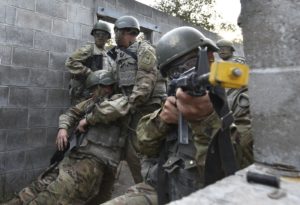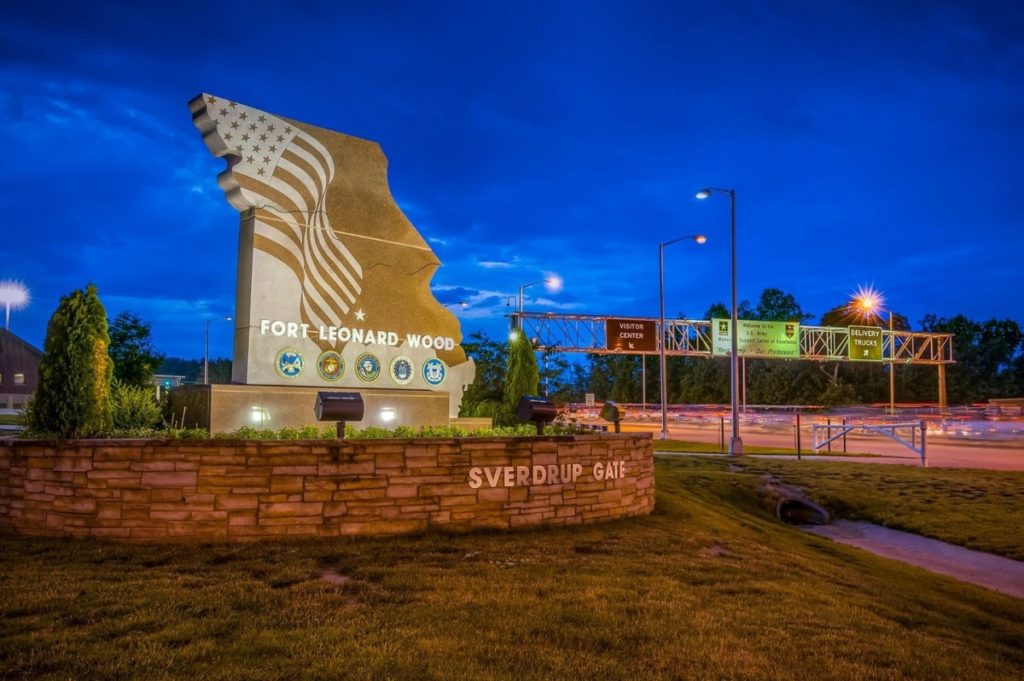Brian Hill
FORT LEONARD WOOD, Mo. (Oct. 14, 2020) — The sound of a CH-47 Chinook helicopter bounced around the hills as it flew in low over the trees, following the course of the Big Piney River at the eastern boundary of the installation near Training Area 250. As it approached the helicopter landing zone, or HLZ, early morning mist and colorful leaves were blown down over the 184 combat engineer and bridge crewmember trainees from Company C, 35th Engineer Battalion, waiting in small groups to board their flights.
The culminating event of 18 weeks in one station unit training, or OSUT, was a field training exercise the morning of Oct. 8. But while the trainees looked forward to showing off their newly honed Soldiering skills, the opportunity to experience an autumn flight over the Ozarks was a special treat — one that Missouri-native Pvt. Kassie Albert said made her “really proud.”
“I’ve never been on a helicopter, or even a plane, and I didn’t really know what to expect,” she said. “Being able to see this part of Missouri from above was incredible.”
According to Sgt. 1st Class Juvenal Luna, the company’s senior drill sergeant, it’s been some time since a training unit here has been able to schedule something like this.
“This is the first time in a few cycles that a company has been able to coordinate with aviation,” he said. “It’s really hard — weather comes into play, and sometimes they can’t support because there are bigger missions going on — so, we’re really fortunate to be able to have them. It’s a really great experience for everybody.”
Luna said having aviation here “makes all the difference” in helping the trainees gain a more complete picture of their military occupational specialty.
“I want these new Soldiers to have an understanding of the fundamentals of what it takes to be an engineer — how to execute the tactics they’ve learned here while also getting an overview of what the Army does,” he said. “They need to know how air, land and sea works in warfare — to get a feeling for how that all works together logistically.”
The Chinook flew here from New Century, Kansas, — a suburb of Kansas City — where it’s assigned to Company B, 7th Battalion, 158th Aviation Regiment, an Army Reserve unit.
“We’re always happy to assist the Fort Leonard Wood training mission when we can,” said Chief Warrant Officer 4 Mitch Higgins, the pilot in command of the mission. “Providing those trainees with a chance to gain familiarity with our Army air capabilities just enhances their overall experience.”
Throughout the morning, combat engineers demonstrated their knowledge of patrolling, intelligence gathering, route clearance, placing and breaching obstacles, urban breaching and search operations.
“The objective is to make sure our engineer trainees are transformed from civilians into Soldiers who know their MOS,” said Staff Sgt. Arielle Mailloux, one of the company drill sergeants tasked with coordinating the exercise. “They have to know how to move from point to point, applying their knowledge and working as a team.”
Mailloux pointed out the trainees led themselves throughout the cumulative FTX. The drill sergeants were present as observers.
“This was one of the youngest cycles we’ve had recently — also, one of the sharpest,” she said. “I think the average age is less than 21 years old. It’s pretty impressive how they changed and have grown over time.”
The urban breaching stage of the FTX featured smoke, explosions and opposition forces. The trainees had to search multiple buildings, disable or circumvent booby traps and exfiltrate casualties.
After completing that portion of the morning, Pvt. Alexis Nibarger said she couldn’t imagine a real-world situation being much different.
“I think it would be more stressful in a combat zone, but I feel like this was the closest it could get,” she said.
Nibarger said she felt prepared because of her “amazing training.”
“The training environment here is the best — I never thought I’d be doing this,” she said. “I was taught how to communicate better and work as a team with different people from all over the world. I’ve learned how to blow stuff up and kick down doors — my job is really exciting!”
For Pvt. James Yannick, who worked alongside Nibarger to breach the mock urban environment, the instructors made all the difference throughout his time here.
“We had incredible instructors who taught us how to cope with stress,” he said. “I just applied what they taught, and I’m still here.”
While the combat engineer trainees made their way to the lake at TA250, bridge crewmember trainees demonstrated boat launching and raft construction.
Mailloux said the two specialties then had to work together to cross the lake.
“All of the combat engineers and bridge crewmembers do this event together,” she said. “They get to see how their MOSs mesh up with one another. This FTX is extra special, though; it’s got land, sea and air — everything that is Army.”
Graduation is tomorrow, and Luna said he’s happy this cycle of trainees could have one final flying hurrah.
“Being able to experience a flight like that is unforgettable,” he said. “That’s where we try to get with the trainees — to never forget where they started.”






-30-
About Fort Leonard Wood
Fort Leonard Wood is a thriving and prosperous installation that has evolved from a small basic training post more than 75 years ago to a premier Army Center of Excellence that trains more than 80,000 military and civilians each year.
Fort Leonard Wood is home to the U.S Army Maneuver Support Center of Excellence and three U.S. Army schools: the U.S. Army Engineer School; U.S. Army Chemical, Biological, Radiological and Nuclear School; and the U.S. Army Military Police School. In addition to training engineer, CBRN and military police specialties for the Army, Fort Leonard Wood also provides gender-integrated in-processing and Basic Combat Training for new Soldiers.
Fort Leonard Wood also hosts and trains with the largest Marine Corps Detachment and Air Force Squadron on any Army installation as well as a large Navy construction detachment.
More information about Fort Leonard Wood is at: https://home.army.mil/wood/index.php/about/mission


